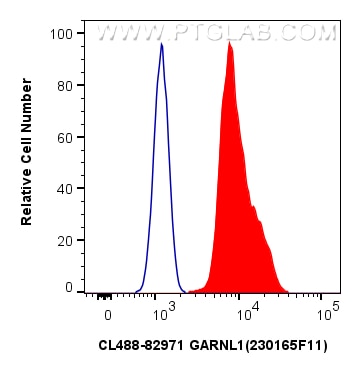Tested Applications
| Positive FC (Intra) detected in | U2OS cells |
Recommended dilution
| Application | Dilution |
|---|---|
| Flow Cytometry (FC) (INTRA) | FC (INTRA) : 0.40 ug per 10^6 cells in a 100 µl suspension |
| It is recommended that this reagent should be titrated in each testing system to obtain optimal results. | |
| Sample-dependent, Check data in validation data gallery. | |
Product Information
CL488-82971 targets GARNL1 in FC (Intra) applications and shows reactivity with human samples.
| Tested Reactivity | human |
| Host / Isotype | Rabbit / IgG |
| Class | Recombinant |
| Type | Antibody |
| Immunogen | GARNL1 fusion protein Ag31518 Predict reactive species |
| Full Name | GTPase activating Rap/RanGAP domain-like 1 |
| Calculated Molecular Weight | 230KD |
| Observed Molecular Weight | 260 kDa |
| GenBank Accession Number | NM_014990.3 |
| Gene Symbol | GARNL1 |
| Gene ID (NCBI) | 253959 |
| RRID | AB_3673158 |
| Conjugate | CoraLite® Plus 488 Fluorescent Dye |
| Excitation/Emission Maxima Wavelengths | 493 nm / 522 nm |
| Form | Liquid |
| Purification Method | Protein A purification |
| UNIPROT ID | Q6GYQ0 |
| Storage Buffer | PBS with 50% Glycerol, 0.05% Proclin300, 0.5% BSA, pH 7.3. |
| Storage Conditions | Store at -20°C. Avoid exposure to light. Stable for one year after shipment. Aliquoting is unnecessary for -20oC storage. |
Background Information
GARNL1/RalGAPα1, a major α subunit of the Ral-GTPase activating protein in skeletal muscle, is a protein whose phosphorylation and binding to the regulatory 14-3-3 proteins is stimulated by insulin and also by muscle contraction (PMID:24768767).
Protocols
| Product Specific Protocols | |
|---|---|
| FC protocol for CL Plus 488 GARNL1 antibody CL488-82971 | Download protocol |
| Standard Protocols | |
|---|---|
| Click here to view our Standard Protocols |



